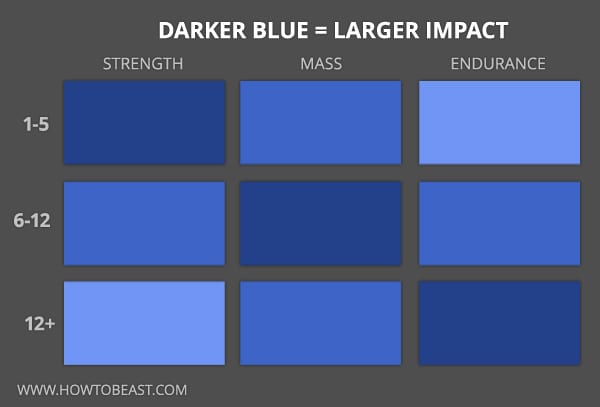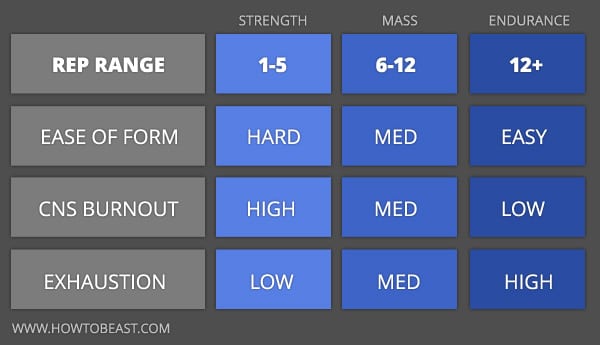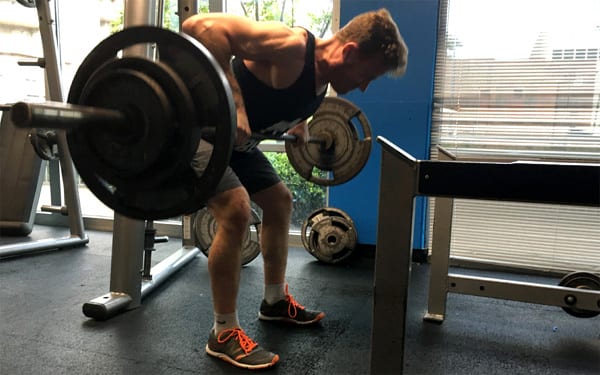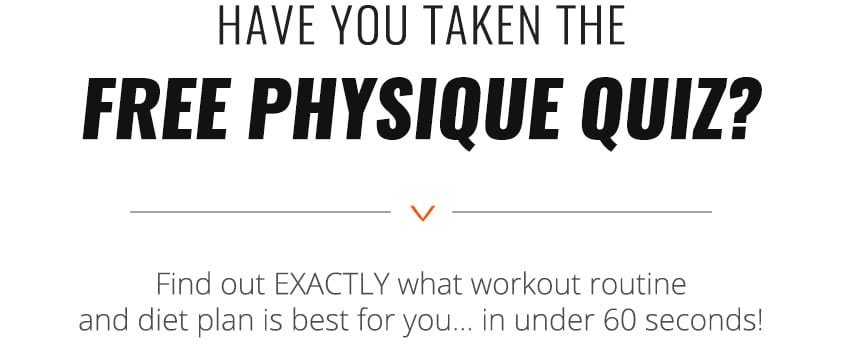How many reps is best for building muscle?
It’s one of the most common questions guys have about lifting weights.
In this article I’ll breakdown the science behind different rep ranges, so you know exactly what you should be doing to build the most mass.
What the Science Says

People generally believe that low reps (1-5) are best for strength, medium reps (6-12) are best for size, and high reps (12+) are best for muscular endurance…
NOTE: The chart above displays this common belief (NOT the scientific truth).
But is there any scientific proof to back up these beliefs?
The answer is yes and no. Let me explain:
- If your goal is to get as strong as possible, then low reps is clearly best, because it allows you to lift heavier weights…
- If your goal is to build endurance, then high reps is clearly best, because it allows you to lift for an extended period of time…
- But if your goal is to build muscle, there’s no obvious answer, because this is an aesthetic goal (NOT a functional goal)
That being said, a number of studies have been done on how different rep ranges affect your ability to build mass. Rather than getting super technical and breaking down all the complex testing methodologies and statistics, I’ll cut to what you care about: the results.
Greg Nuckols of Strengtheory.com recently conducted an in-depth analysis of the top 20 studies investigating rep ranges, and this was his conclusion:
Of the 20 studies… 17 reported no significant differences in hypertrophy in the most relevant comparison groups… but on average the ‘hypertrophy range’ did slightly better than high reps or low reps.
In other words, different rep ranges caused very little difference in muscle growth.
Yes, the medium range (6-12) had a slight edge, but you can still build muscle efficiently in the low (1-5) and high (12+) rep ranges.
The Real Reason 6-12 Reps is Best

Even though these studies found that rep range does not have a huge impact on mass, there’s still one big reason you should focus on 6-12 reps if your main goal is to build size.
Here’s why…
In order to build mass, you need to maximize the number of high quality reps you do (per muscle group) over the course of each week.
When I say ‘high quality reps’ I mean reps that maintain good form and are still relatively challenging for you to complete. These reps will place enough stress on your body to induce muscle growth, but avoid overstressing your body and extending your recovery time.
By doing a lot of high quality reps, you’ll maintain higher levels of muscle protein synthesis, and build more size.
Here are 3 reasons why 6-12 reps is best for achieving this…
#1: Better Form Than Low Reps
When you’re working with low reps, at an intensity that’s close to your 1 rep max, it’s becomes challenging to control the weight and maintain good form.
While this isn’t a reason to avoid low rep work, your form will be better (on average) when doing medium and high rep work. And this means that your average rep will be higher quality.
Here, higher quality means that you’re more likely to take the weight through a full and proper range of motion (from the first rep until the last). Think of how many guys start half squatting or half benching when they get close to their max. This type of cheating diminishes the ‘efficiency’ of the rep, and hinders your ability to build mass.
#2: Less ‘Burnout’ Than Low Reps
Another advantage of 6-12 reps is that it avoids the ‘CNS Burnout’ you experience with low reps.
The exact physiological processes by which this happens are often debated, but you can’t deny there’s a certain mental fatigue you experience after deadlifting or squatting close to your max.
Even though you aren’t physically tired, your brain feels foggy and you lose motivation to keep working out at a high intensity. And this results in lower quality reps for the remainder of your workout… and less gains throughout the week.
A final reason medium reps are best for building mass is that they avoid the physical exhaustion that comes with high rep work.
It’s simple: after you grind out a set of 12+ reps, you’re fucking exhausted! And this negatively affects your mental focus, and your physical strength for the remainder of the workout… which limits the number of quality reps you will perform, and the amount of muscle you will build.
To sum this section up: 6-12 reps is best for mass because it offers an effective ‘middle ground’.
It allows you to maintain good form and keep the intensity high, without getting too mentally ‘burn-out’ or physically exhausted. And this means you get more high quality reps over the course of the week, resulting in more mass being built.
Best Rep Range by Exercise

Different exercises require different amounts of power, stabilization, and mobility. And this makes different rep ranges better suited to different exercises.
Below I’ll offer my suggestions… but my general recommendation is to go with what ‘feels’ best to you.
If doing more than a few reps of a certain exercise makes it difficult for you to maintain good form, then stick with low reps for that movement. If going heavy and doing low reps makes you feel ‘shaky’, then stick with higher reps for that exercise.
Compound Barbell Movements
Examples: Squats, bench press, overhead press, bent over rows.
Recommended Reps: 5-8
Reason: Barbell compound movements allow you to move more weight (and build more strength) than any other exercises. You should take advantage of this fact and stick to slightly lower reps, which allow you to maximize the amount of weight you’re using.
*Deadlifts are an exception here. For deadlifts I recommend sticking to sets of 3 reps, because it’s a ‘power’ movement that’s better suited to using heavier weights. Also, form can break down after a few reps, and the risk of serious injury is greater than with most exercises.
Compound Dumbbell Movements
Examples: Lunges, goblet squats, chest press, shoulder/arnold press, rows.
Recommended Reps: 8-10
Reason: Dumbbells always involve some degree of instability, so you don’t want to go too heavy. Otherwise you’ll be too focused on getting the weights into place and keeping them balanced, rather than pushing yourself. But these are still compound movements that can build good strength, so you don’t want to go too high either.
Isolation Movements
Examples: Curls, tricep extensions, shoulder flys, abs/core exercises.
Recommended Reps: 8-12
Reason: The point of isolation work is to build size in your ‘beauty’ muscles (arms, shoulders, abs). There’s not much benefit to going heavy, plus they put all of the stress on a single joint (whereas compound movements distribute the load over several joints), so going heavy can quickly lead to overuse injuries in the tendons and ligaments surrounding your joints.
Conclusion: Best Rep Range for Mass?
The best rep range for building mass is 6-12 reps.
It’s been proven to have a slight advantage in studies, and it allows you to pack in a higher number of quality reps over the course of each week.
However, there are still reasons to use other rep ranges. Some exercises, such as deadlifts, are better suited to lower reps for example.
Also, switching up your rep range when you hit a plateau is an effective way to break through the plateau. For example, using low reps builds more strength and power, while using high reps builds more endurance and oftentimes leads you to improving your form.
Therefore, I suggest you incorporate all rep ranges into your training, while focusing most of your sets in the 6-12 range.




Great article. Far too many contradictory, anecdotal information out there on this topic. This explains it all very well.
Thanks Jack, I’m glad you liked it man!
Excellent article. I came across it by searching for rep ranges for the deadlift. HOW TO BEAST now has a home on my ‘strength’ speed dial.
Good work David!
Thanks Greg – love your website man!
real balanced and toughtful article;really makee sense for that i have experient the last plus 25 years in the iron game..thx from wesseboyman sweden
Nice guidelines David, simplifies things greatly. I’ve always wondered about this as you see guys who stay with powerlifting type work yet get big and then those who go pure bodybuilder yet also put on size. Will have to keep these rep ranges in mind. I think most people discount the quality of work for the quantity but as you say not every rep is going to be the same and that is going to make a big difference.
Thanks Charles. I really believe the idea of maximizing quality reps is key, because it tends to ‘auto-regulate’ the volume and workload that you use.
David, once again, thanks for your advices. After a deload week and getting back on track, I now have a more clear vision of the reps for each kind of exercise which is very important for mass.
You’re welcome Braulio! Go get after it.
Hi from colombia,
How about velocity? is it better to lift faster or slower for building muscle ?
Hi Andres, in general I recommend a slow, controlled negative (going down) and a fast, explosive concentric (going up).
Hey David
Cool post!
What I miss is what you think about time under tension. IMO that counts more than the number of reps. Plus, how many sets do you recommend? TUT and number of sets are at least equally important as the number of reps.
ATM I do 1 set to failure (some exercises focusing on exentric, some reducing the weights after 6 reps etc.), 9-12 reps, 90-120 seconds TUT.
thanks for your help!
I don’t think TUT is a great measure of anything to be honest.
Quick contractions actually recruit more muscle fibers and motor units than slow reps, so focusing on increasing TUT can even hinder your progress.
Getting in quality reps wins over all.
In terms of sets, it’s going to depend on strength level and experience. We can all tolerate different levels of volume, so the main thing is to gradually increase over time IMO.
I like to do 5×5 with dumbbells for upper and lower body once a week during a 3 day upper lower split
Week 1
Upper with a 5×5 protocol
Lower using the rep goal system 4 sets rep goal 29
Based on a 6 rep average
Upper using a rep goal averge of 10.5 so 4 sets rep goal 47
Week 2
Lower body 5×5 workout
Upper body 4 sets rep goal 29
Lower body 4 sets rep goal 54
Should i not do any 5 rep work with dumbbells even though i am only doing it once per week with upper and lower body ?
Thank you for your time
G Hutchison
Based on your post, I’m not sure exactly what you’re doing. It depends on whether or not that extra volume is useful for you, or whether it’s limiting your recovery.
Kudos man! Subject appeared boring but on reading I aha-ed over and over! Lot of interesting and helpful details in the article, thanks.
David ,
Good show, can u provide the same article for Proteins and Supplements like above.. ?
Check out my recommended supplements here: https://www.howtobeast.com/recommended-supplements/
Thanks David ..
I’ve tried all rep ranges over my 30 years of training. But have always returned to 3×5 for the bulk of my lifts. Everyone is wired different so experiment will many different set and rep ranges. You’ll eventually find the set rep range that works best for you.
what about progressive overload ? isnt progressive overload key to more muscle mass? so how does this work for the 6-12 rep range ?
Yeah progressive overload is very important. Check out this article, it explains how to apply it to your training: https://www.howtobeast.com/progressive-overload/
I m a skinny guy please help me out.All classmet are joking abt me in class . I m so fustrated please help me……
Hey Bro, I’m a fitness instructor/dietician. If you’d like help I’ll help you for free. Bullies can be very cruel.
email me: r.s.business.enquiries@gmail.com
Hi David,with the help of your advice and bulking videos I have seen results within weeks,thank you.
Could you recommend any good routines that are based off these rep ranges?
Yes, check out my free bulking routine: https://www.howtobeast.com/get-jacked
This is a great article, very logical and well thought out. I particularly like the different rep ranges for different types of exercises, something I’ve long advocated in my own training and my clients.
Thanks man!
Great article. In support of what you write, recent research suggests that the key variable for hypertrophy is total weight lifted (aka, volume-load), that is: reps x sets x weight. You can use whatever rep range you like as long as this value is increased over time (progressive overload). And you are quite correct that different rep ranges have different advantages over others when it comes to rep quality.
Thanks man! And great explanation!
Can I know that how many sets to be done for 6-12 rep ranges..?
Good Article
Liked the article, and on point with the science! 🙂
Would say that for shouldef flys doing 8-12 reps is a bit heavy on the shoulders for a lot of people. It’s safer going a bit lighter like 12-15 reps, espeically on lateral raises.
Here is something i haven’t tried yet and would like your opinion on. Seems to me a good way to go is to pick a heavy weight you can barely do 3×6 with. Start working with it and try to increase the reps until you’re at 3×12. At that point you could probably add 30 pounds and start over again with 3×6. Seems like you would be keeping your muscles off balance like when using cycles and your using progressive resistance as well as getting the benefits of the entire 6-12 rep range. What do you think?
hello David. I do 10 to 12 reps 5 sets. 4 different exercises per body part. I am not sure if I am supposes to be taking more rest time. I done workout o n the weekends. would I rest more? 3 on 2off Kind of Thing?
David My Darn Keyboard is sticking
Love this article Bro, keep up the solid information!
Great article. Could you please say if the same rep could use for women too.
Specialty, if the target is decrease the fat around the shoulder and triceps .
David My Darn Keyboard is sticking
Based on the chart:
Medium reps: 2+2+2=6/3= 2nd place
Higher reps: 1+1+3= 1.66 (1st place)
So I’m not sure how medium reps wins.
How many sets would you suggest for a senior man that is doing 2 sets of 15 reps at the present time? After reading the article (great article) I’m going back to the 6-12 reps but not 100% clear on the sets range.